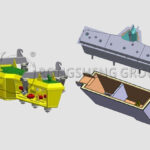How to Configure Refractory Materials in the “Ecological Cement” Production Line?
Ecological Cement refers to a hydraulic cementitious material formed by calcination using municipal waste incineration ash and sewage sludge as main raw materials. In addition to its practicality as a building material, the basic function of ecological cement is to maintain human health and protect the environment.
How to consider the supporting refractory materials of the “ecological cement” production line is a very important issue.
It is well known that it is more difficult to control the alkali-sulfur ratio of 1:1 after changing the conditions of raw coal combustion. Due to the large fluctuation of the working medium (solid, liquid, gas), the erosion and damage to the refractory material are aggravated; The instability of raw materials and fuels requires higher thermal shock resistance, anti-flaking and anti-skinning properties of refractories, especially resistance to permeability.
Therefore,
The length of the firing zone needs to be extended from the original 6D~8D to 8D~10D;
Inert composites containing ZrO2, Ti02 or A1203-Zr02, MgO Zr02, A1203~ MgO Zr02, A1203-Zr02-S102 (AZS) materials with “dual” compound properties will highlight their properties;
Special anti-seepage and anti-corrosion performance are excellent, used for sintering in metallurgical traditional industries, and it is possible to cast the castables to “ecological cement” production;
For the medium phase of traditional refractory materials, combined with the resistance of acid and alkali, sulfide, chloride corrosion, the development of anti-flaking performance is urgently improved.





